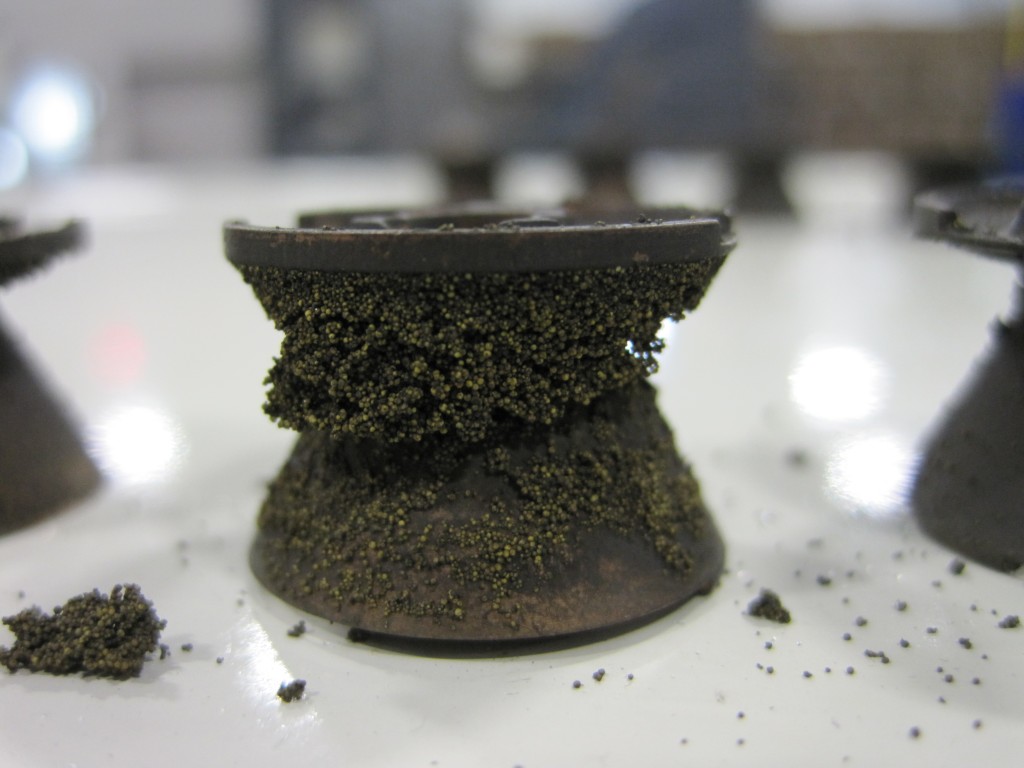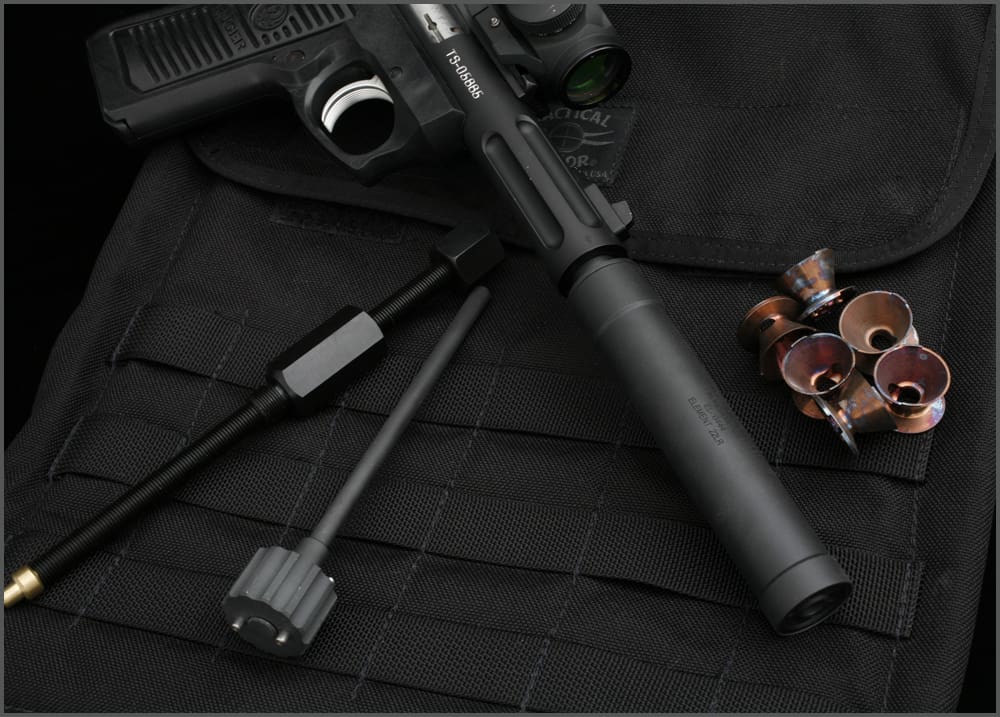Nothing in this world shoots as quietly as a silenced .22lr rifle. Nothing except an airgun, but that’s cheating and you know it. AAC makes three different silencers for rimfire calibers, the Pilot 2, the Element, and the Prodigy. I recently had a chance to fire all three from the same gun using the same box of ammunition and got it on video. Right now let’s focus on the Rolls Royce model, the Element.
As a preface, I just wanted to emphasize that this is not a “full” review of this product. Here at TTAG we usually reserve judgment until we’ve put a couple hundred rounds through something and tried it out in different conditions. Unfortunately the BATFE here in the U.S. prevents us from getting our hands on silencers for protracted testing unless we go through months of waiting, spend $200 per transfer, and live in certain states. It’s impractical. Luckily I recently had a chance to visit the Advanced Armament Corp. factory and test all of their cans under their supervision. While the tests may not have been as complete as I want, they were good enough for a brief review.
In some ways, the Element is just like the Pilot 2 (the least expensive of AAC’s rimfire silencers). It uses a metallic baffle design that comes apart into a set of small and leaky cups, uses a 1/2-28 thread mount, is just about an inch wide and has no internal decoupler. But that’s where the similarities stop.
Unlike the Pilot 2, which AAC warn against disassembling for fear of never putting it back together right, the Element was designed with disassembly in mind. The can comes with a tool (the threaded thinger pictured above) that was intended to be threaded onto the back of the silencer and used to push the baffles out of the tube, much like a butcher making sausages pushes the random bits of meat out of a grinder. The “alignment rod” (the non-threaded dealie) keeps everything aligned when reassembling the can, and also acts as a wrench for the front end cap.
The ability (and recommendation by AAC) to thoroughly clean this can after use makes my inner OCD child happy, as .22lr is an exremely dirty round. To illustrate just how dirty it gets, here’s a picture of one of the Element’s elements after a demonstration live fire session.
 The thought of that much crud being in one of my cans makes me cringe a little inside and start looking for the rubber gloves and toothbrushes.
The thought of that much crud being in one of my cans makes me cringe a little inside and start looking for the rubber gloves and toothbrushes.
Disassembly is nice, but the real question is how well it shoots. To answer that question AAC took me to their top secret testing facility in Georgia (AKA some random field on Kevin’s farm) to try out their wares. I test the Element at about 3:06.
http://www.youtube.com/watch?v=RpcJf5pwKQk
What were my impressions? Well, I was very impressed with the sound reduction of this model. I was happily plinking away without hearing protection (much like FPSRussia, but without the impending deafness), and the loudest thing I heard was the bullet hitting the berm. The gun going off sounded more like a small fart than the loud pop I usually associate with .22lr, definitely something I wouldn’t be afraid to commit a little varmint genocide with in my backyard.
The added sound suppression is nice, but it’s not really the top draw for this model. This is AAC’s only rimfire silencer that is rated for .22 Magnum as well as .17 HMR, meaning it can be used on a wide variety of firearms and calibers beyond just the .22lr tubes. The “one can to rule them all,” if you will. If you only own a .22lr firearm, however, the $250 jump in price between the Pilot 2 and the Element can be a little hard to justify. Both of these cans will suppress the report of the shot enough to be “hearing safe,” but the Element will definitely be the quieter of the two.
AAC’s Element silencer really does work. It makes your rimfire firearm hearing safe, and probably quiet enough to be used in a (properly configured) back yard. For me, the ease of disassembly and the variety of calibers it supports makes this can a winner in my book. There are some drawbacks as well; the complicated disassembly process and the multiple baffles make me a little hesitant to plop down the cash and wait 4 months for it. There are less complicated silencers available, but then again if you want to shoot all of the calibers this is the one you need.
Element – Rimfire (.22lr / .22 Mag / .17 HMR) Silencer
Length: 5.25″
Weight: 4.3oz
Diameter: 1″
Sound Reduction: 41 dB
MSRP: $595
Ratings (out of 5):
Sound Suppression: * * * *
This thing is almost whisper quiet. Like I said it’s more like the gun is farting than firing, and the only thing really making noise is the action of the pistol. Put this on a bolt gun and that squirrel will never know what hit him.
Build Quality: * * * *
Top shelf materials and treatment make this can more resilient and able to last longer than most others. Just holding it in your hand you can feel the quality. But like the other rimfire cans the thin skin makes me a little bit nervous.
Ease of Use: * * *
Using is easy, cleaning is easier than the Pilot 2, but it’s still not as idiot proof as the Prodigy.
Overall Rating: * * * *
It’s the most expensive rimfire can AAC makes, but it fires just about everything.
(Pictures courtesy Advanced Armament Co.)
Click here for the user’s manual.






What about the Russian/Soviet PSS Pistol?
http://world.guns.ru/handguns/hg/rus/pss-silent-e.html
Hi Nick: I’m surprised by the amount of crud / residue. I’ve never experienced that amount of soot / debris in my .22 can. What kind of ammo were you using?
Joe,
That’s a photo one of the guys at AAC took after a weekend long live fire demonstration event. Like, thousands of rounds of ammunition in 48 hours using the cheapest and dirtiest available.
My FFL describes the ‘silencer giggle’, that unavoidable chuckle after shooting with a can. I see you’ve got it in this video. I get the same thing everytime I shoot my AAC Element.
What is the pistol in your July 27, 2011 .22 suppressor review?
do you have any more recent .22 suppressor reviews?
I have had an AAC Element for about two years. I can shoot thumb – size groups at 30 yards with a Browning Buckmaster, 2 inch groups at 30 yards with a Walther P22 (the lightest and coolest suppressed .22 cal. hand gun IMHO) with the Element attached. However, we come to my Ruger 10/22 rifle. I started out with an inexpensive scope and had the barrel threaded for the Element. The rifle shot 1″ groups at 30 yards with the inexpensive scope and no Element attached. I attached the Element and couldn’t hit paper. So I put on a Leopold 3-9x scope, had the barrel rethreaded, installed a Timney trigger and a pachmyer stock. I can shoot 5 rounds practically through the same hole at 30 yards without the Element. I install the Element and I can’t get a group under 4-6″. I’m going to try subsonic ammo next but I think I shouldn’t have to use subsonic to get accuracy (if they work). Has anyone else had a similar problem using and element on a rifle. I know I’m a little late with this but I just found this site.
I appreciate any input because I am about out of options and now have a very nice custom 10/22 that still doesn’t shoot worth a s**t with the Element.
Frustrated in Texas, a bad combination!
This review is a few years old, but I unfortunately have a similar experience. I purchased an AAC Element 2 for my CZ-455. After waiting nearly 10 months to get my tax stamp, I was very excited about getting it sighted in. To my dismay, my groups took a noticeable step backward.
With the Element 2, I fired five groups of five rounds each at 50 yards using Eley Subsonic HP. The three best groups averaged 3/4″. A repeat of the same exact test with a different suppressor yielded groups with an average size of 7/16″. That is a 50% increase in group size, which more than doubles the size of the circle where a shot is likely to land. I am very disappointed.
Comments are closed.